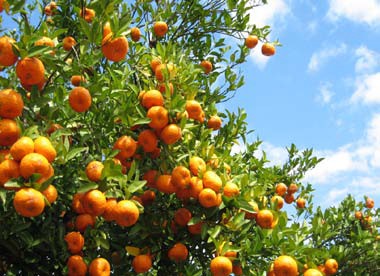Diatomaceous earth has been used by the most advanced citrus growers in varying countries around the world with great success. The move by many toward natural silica based fertilizers was largely brought about by the significant benefits revealed in research carried out by the University of Florida. Additional research by various organizations and the results experienced by citrus growers have clearly shown that silica-based fertilizers such as diatomaceous earth are vital in maximizing citrus production.
Citrus responds extremely positively to diatomaceous earth with appropriate levels of natural silica, and it is necessary for the tree to have sufficient levels of silica if lower than maximum yield is to be avoided. Low yield is only one of the negative outcomes of Silica deficiency:
1. Lower than optimal yield rates
2. Shorter shelf life
3. Lower sugar content
4. Longer growth period
5. Increased susceptibility to disease, insect and fungal attacks
6. Higher production expenses i.e. more fertilizer, insecticide, fungicide.
There are several reasons why diatomaceous earth can overcome these negative outcomes but the main reason has to do with its primary function within a citrus tree:
• Primary function of Nitrogen – Biomass
• Primary function of Phosphorus – Energy
• Primary function of Potassium – Growth
• Primary function of Silica - Plant Defence System
If there is a silica deficiency, the energy and resources of the tree that should be used to produce a maximum yield of high quality fruit with a long shelf life and high sugar content, are instead used to protect the tree from the myriad of stresses that impact it every day. If sufficient quantities of silica are available to the tree it is able to continue its growth and production at a maximum rate while simultaneously fighting the impacts of fungi, disease, insects, low temperature etc, at its maximum rate.
Three of the most common stresses that limit citrus production are Salt, Aluminium and Low Temperatures. The following table illustrates the potential loss in production if insufficient silica is available to Citrus trees.
|
Salt |
Aluminium |
Temperature | |
|
Weight of Fruit |
-30% |
-52% |
-38% |
| Weight of Roots |
-49% |
-50% |
-38% |
Due to the fact that a citrus tree needs to use its energy and resources on plant defense instead of biomass, growth and production, citrus growers can experience significant loss in yield and quality without even realizing it.
Even when new trees are planted in soil that is deficient in Silica, significant loss in growth rates can be experienced. Within the first six months citrus trees could experience the following in the first six months when compared to trees with sufficient Silica.
• Tree height loss of between 14 and 41%
• Branch length loss of between 31 and 48%
One month old grapefruit seedlings (above)
Of serious consideration is that Silica deficiency can reduce growth rates by 30 – 80% and decrease fruit maturation time by 2 – 4 weeks.
While Silica is essential for maximum production and profits not all Silica is the same. In order to effectively address all the problems related to Silica deficiency the Silica product must have the following:
1. A high level of plant available amorphous silica (beach sand is 95% but none of it is plant available and therefore no benefit to the Citrus tree at all.)
2. Provide a high level of water-soluble silica
3. Have a high level of residual silica
4. Contain beneficial trace elements
5. Contain no toxic levels of any element, pollutants or heavy metals
Many silica products meet some of these requirements however, very few meet them all. Some products have high levels of silica but the silica is low in plant availability. Other products have high levels of plant available silica but it is contaminated with heavy metals.
Natural Silica manufacture by Synergy Fertiliser contains a high level of plant available amorphous Silica, a high level of water soluble and residual Silica, many beneficial trace elements and does not contain dangerous levels of any toxic element or heavy metal.
PREMIUM GRADE AUSTRALIAN DIATOMACEOUS EARTH
Recommended Reading
1. Matichenkov, V.V., Calvert, D., Snyder, G. 1999. Silicon fertilizers for citrus in Florida
2. Ma J.F., Miyake Y., Takahashi E. 2001. Silicon as a beneficial element for crop plants.
3. Matichenkov, V.V. 2004. Silicon in food, agriculture and environment
4. Chapman, H. D. 1968. The mineral nutrition of citrus. In W. Reuther (ed.), The Citrus Industry 2:127-134.
5. Epstein, E. 1999. The discovery of the essential elements. Discoveries in plant biology, v.3 S.D. Kung and S.F. Yang (ed), World Scientific Publishing.
6. Taranovskaia, V. G. 1940. The role of silicication for citrus, tunga and siderates. Soviet subtropics 5:38-43.
7. Abraham, A., Laing, M., Bower, J., Clark, C. 2009. Preharvest or postharvest silicon treatment for the control of postharvest penicillium digitatum of citrus fruit.
8. Matichenkov, V.V. and E.A. Bocharnikova. 2000. The relationship of silicon to soil physical and chemical properties.
9. Wutscher, H. K. 1989. Growth and mineral nutrition of young orange trees grown with high levels of silicon. HortScience 24:275-277.
10. Mathaba, N., Tesfay, S., Bower, J., Bertling, I. 2009. The potential postharvest silicon dips to mitigate chilling injury in citrus fruit with special emphasis on lemon
11. Matichenkov, V.V., Bocharnikova, E., Calvert, D. 2001. Response of citrus to silicon soil amendments
12. Epstein, E. 1999. The discovery of the essential elements. Discoveries in plant biology, v.3 S.D. Kung and S.F. Yang (ed), World Scientific Publishing.


